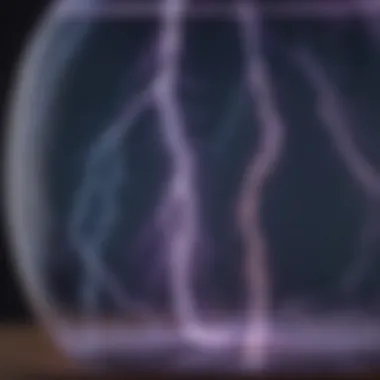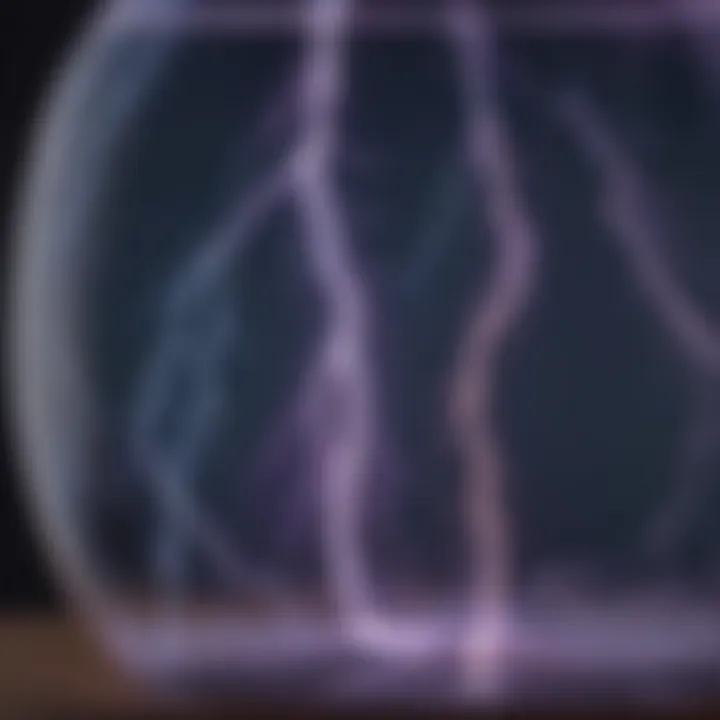Unleashing Electricity: The Lightning in a Jar Experiment


Intro
The 'Lightning in a Jar' experiment stands as a fascinating way to demonstrate key principles of electricity and electrostatics. It is not just a visual spectacle; it provides a practical insight into how charges interact in the natural world. For educators, parents, and young learners alike, this experiment serves as a gateway to understanding the underlying concepts of electricity and its various forms. Through this guide, we aim to explore the diverse elements involved in conducting the experiment, as well as the various scientific concepts that come into play.
Science Fun Facts
Interesting Trivia and Facts
- Did you know that the first recorded scientific observation of electricity dates back to ancient Greece? Thales of Miletus noted that rubbing amber attracted lightweight objects, a phenomenon that we know today as static electricity.
- The concept of electrostatics, which is crucial for the 'Lightning in a Jar' experiment, involves charges that can vary based on the materials used, leading to different effects.
Quirky Science Stories
In the 18th century, Benjamin Franklin famously conducted his kite experiment in a storm to study lightning. This risky endeavor demonstrated the electrical nature of lightning, linking it to the principles later shown in the 'Lightning in a Jar' experiment.
Amazing Science Records
One of the most striking records related to electrostatics is the highest voltage ever recorded in a laboratory trace, which was over 100 million volts. While such conditions are extreme, the fundamental principles remain the same in smaller scales demonstrated in this experiment.
Thought-Provoking Questions
- How does friction create static electricity?
- In what ways could understanding electrostatics impact technology in the future?
Discover the Wonders of Science
Exploring Various Scientific Concepts
This experiment helps illustrate concepts such as charge, voltage, and circuits. Understanding these ideas is fundamental not just in science, but also in realizing their applications in everyday life.
Educational Videos and Animations
Many educational platforms, like Khan Academy or TED-Ed, offer resources and videos that further explain electrostatics and electricity in an engaging manner.
Interactive Learning Tools
Lab kits designed for children can offer hands-on experiences. These tools often come with guided instructions to enhance the learning experience while ensuring safety.
Real-Life Applications of Science
The principles of electrostatics are found in everyday technologies. Applications range from printers to air purifiers, showing that this fundamental science is part of our daily lives.
Science Quiz Time
Interactive Quizzes
Websites like Quizlet or Kahoot can be used to create quizzes about electricity and electrostatics, making learning interactive and fun.
Multiple Choice Questions
- What is static electricity?
- A) Electricity that is always on
- B) Electricity that builds up on a surface
- C) Electricity produced by generators
- D) None of the above
Brain Teasers and Puzzles
Whether it’s matching scientific terms with their definitions or solving problems involving electrical circuits, engaging brain teasers can deepen understanding significantly.
Learning Through Gamification
Utilizing games that involve scientific principles allows children to learn while having fun, solidifying their knowledge through interactive methods.
Science Experiment Showcase
Fun and Engaging Experiments
The 'Lightning in a Jar' experiment is one of many experiments that can captivate young minds. It encourages curiosity and critical thinking.
Step-by-Step Instructions
To perform the experiment:
- Gather a jar, a balloon, and a dry surface.
- Inflate the balloon and rub it on the dry surface to build static electricity.
- Slowly bring the balloon near the jar and observe the electric charge at work.
Materials List
- Glass jar
- Inflatable balloon
- Dry material for rubbing (like wool or fleece)


Safety Tips and Precautions
When conducting this experiment, safety is paramount. Ensure the area is dry to avoid any hazards. Supervision is recommended for younger children.
Important: Always be cautious around other electrical devices.
This experiment not only teaches scientific principles but also promotes a safe learning environment for children, making it an enriching activity for everyone involved.
Preface to the Lightning in a Jar Experiment
The Lightning in a Jar experiment serves as a practical and visually stimulating demonstration of fundamental concepts in electrostatics. This experiment not only captivates the imagination of young learners but also provides a concrete way to explore complex scientific principles in an accessible format. It is significant for educators and parents who wish to introduce children to the fascinating world of physics in a hands-on manner. By conducting the experiment, participants can observe the effects of static electricity firsthand, which reinforces theoretical knowledge through practical experience.
Furthermore, understanding the mechanics behind this experiment lays the groundwork for discussions on electricity and its various applications in the world around us. Participants gain insights into how charges interact, which is a crucial concept in electromagnetism. The knowledge gained from the Lightning in a Jar can inspire further exploration into other scientific phenomena and encourage critical thinking skills among students.
Understanding the Concept of Electrostatics
Electrostatics is the branch of physics that deals with stationary electric charges. It describes how these charges interact with each other, governed by fundamental laws such as Coulomb's Law. Peaceful interactions between charges can lead to various observable phenomena, such as static cling and sparks. This is particularly relevant to the Lightning in a Jar experiment, where participants create and manipulate electric charges in a controlled environment.
In everyday life, electrostatics is all around us. For example, have you ever noticed your hair standing on end after rubbing a balloon on it? This occurs due to the transfer of electrons between surfaces, creating an imbalance of charges. The principles of electrostatics can be observed in many contexts, making it a crucial concept to understand, not only in science but also in everyday experiences.
The Science Behind the Experiment
The Lightning in a Jar experiment fundamentally relies on the characteristics of electrical charges and the behavior of particles in an electric field. When materials with different electronegativities are rubbed against each other, electrons may transfer from one material to another. This creates an excess of positive or negative charges on the surfaces involved.
In the experiment, a common practice is to use a plastic rod or a glass jar. By rubbing the rod with a cloth, one can generate static electricity. If the charged object is brought near to other objects or conductive materials, impressive displays of electrostatic discharge can occur, mimicking the appearance of lightning. This visual phenomenon can help solidify the understanding of abstract scientific principles.
By observing the electric sparks and the effect they have on nearby materials, participants can witness firsthand the concepts of attraction, repulsion, and discharge. The experiment not only showcases these principles but also encourages curiosity about why things happen, prompting a deeper investigation into the underlying scientific concepts.
Materials Needed for the Experiment
In any scientific endeavor, the materials used play a vital role in the success of the experiment. Understanding what is required not only aids in preparation but also enhances the overall educational experience. For the 'Lightning in a Jar' experiment, having the right materials enables an effective demonstration of electrostatic principles. When young learners see these concepts in action, they will likely develop a deeper interest in science.
Common Household Items
This experiment is unique because it employs items commonly found in most households, making it accessible. Here are the essential materials:
- A glass jar or a clear container
- A small piece of aluminum foil
- A polyester or wool cloth (sock or cloth works well)
- Safety pin (optional)
These items are inexpensive and simple to gather.
The glass jar acts as a medium to showcase electrostatic charges. When the cloth is rubbed on the foil, it transfers electrons, creating a charge. This process enables children to visualize how static electricity works. Additionally, these materials help foster creativity. For instance, children can modify shapes or choose different sizes of jars, sparking their imagination.
Safety Gear Recommendations
While the 'Lightning in a Jar' experiment is largely safe, safety cannot be overlooked. It is essential to use some basic safety gear to prevent any minor incidents. Here are some recommended items:
- Safety goggles: To protect the eyes from any unexpected sparks or debris.
- Gloves: To avoid skin contact with charged materials.
- An adult supervision: Essential for guiding young learners and ensuring all safety protocols are followed.
A commitment to safety in any experiment creates a learning environment where curiosity is encouraged, yet precautions are respected. The implementation of these safety measures fosters a sense of responsibility, helping children understand the importance of safe practices in experiments.
"Safety is not just a practice; it is a fundamental part of scientific exploration."
By ensuring the proper materials and safety gear are available, the experience becomes not only educational but also enjoyable. This preparation sets the stage for a successful journey into the world of electrostatics.
Step-by-Step Guide to Conducting the Experiment
Conducting the 'Lightning in a Jar' experiment is a vital part of exploring electrostatics. This section outlines the essential steps needed to perform the experiment effectively. By breaking down the process into clear steps, both educators and young learners can grasp the significance of each action. This methodical approach helps to foster a deeper understanding of the underlying scientific principles. It also aids in ensuring safety and accuracy throughout the experimental procedure.
Preparation of Materials
Preparing the right materials is crucial for the successful execution of this experiment. Here is a list of items that one needs to gather:
- Jar: A glass jar with a lid is preferred, as it can help to contain any discharges.
- Balloon: This is used to create static electricity through friction.
- Wool Cloth: Rubbing the balloon on a wool cloth enhances the generation of static charge.
- LED or Small Bulb: This will serve to demonstrate the discharge visually.
- Insulated Wires: Connect the bulb and any additional equipment.
- Wrist Strap or Grounding Device: For safety, these should be used while handling electrical components.
Before starting the experiment, organize the materials on a stable surface. Ensure that there is enough room to work safely. If needed, have a notebook ready to record observations.
Executing the Experiment
Executing the experiment involves several specific actions. Here’s a detailed guide to follow:
- Charge the Balloon: Rub the balloon on the wool cloth for about 30 seconds. This action creates static electricity, charging the balloon positively.
- Prepare the Jar: Take the glass jar and make sure it is clean and dry. Remove the lid, if possible, to allow manipulation.
- Bring the Balloon Close to the Jar: Hold the charged balloon near the opening of the jar without touching the surface. You should observe the air inside the jar reacting to the presence of the charge.
- Connect the Bulb: Take your insulated wires and connect one end to the LED or bulb and the other end to the jar. Make sure that the connection is secure.
- Observe the Results: As you bring the charged balloon even closer, watch for any reaction in the bulb. If done correctly, the air's static electricity will create a brief discharge, illuminating the bulb momentarily.
"A well-executed experiment not only demonstrates scientific principles but also ignites curiosity in learners of all ages."
Keep a close watch on the reactions. Take notes about the visibility of discharges, the brightness of the bulb, and any other phenomena observed. This documentation can be useful for later discussions.
Engaging in this step-by-step guide helps to enhance practical knowledge while also imparting valuable lessons about electrostatic energy and safety.


Observation and Analysis of Results
Observing and analyzing the results of the Lightning in a Jar experiment is crucial for understanding the core principles of electrostatics. This part of the process allows participants to connect theory with practical application, thereby enhancing educational outcomes. By examining what occurs during the experiment, learners can develop critical thinking skills, pinpoint discrepancies, and seek explanations for the phenomena they witness. This focus not only amplifies scientific literacy but also cultivates a deeper appreciation of the natural world.
Interpreting the Visual Effects
During the Lightning in a Jar experiment, the visual effects are mesmerizing. As the electrostatic charge builds up, one may see sparks or light flashes, which are examples of electric discharge. Interpreting these visual effects involves understanding the relationship between the charged materials and the air particles around them.
The bright flashes signify the moment when the accumulated charge overcomes the insulating properties of air. This is when electricity travels between the charged object and another surface, often producing a small sound akin to a crack. Such observations illustrate how energy transitions affect the environment. Educators can encourage students to document these observations, leading to discussions about potential variables that might influence the outcomes, like humidity or the types of materials used.
Discussion of Electrostatic Discharges
Electrostatic discharges, the sudden release of stored electrical energy, are central to the experiment. When participants generate static electricity, they are observing a tangible effect of charged particles. This phenomenon can be discussed in a broader context, helping learners connect it to real-life examples, such as lightning or even simple shocks experienced when touching a metal object after walking on a carpet.
Understanding these discharges helps students grasp fundamental scientific concepts, such as the behavior of electrons and the flow of current.
"Electrostatic discharge can pack a lot of power despite its small scale; it's the same principle behind some of the most impactful natural occurrences."
In summary, recognizing the significance of observation and analysis equips learners not only with factual knowledge but also with the skills needed to question and investigate the world around them. By cultivating a mindset centered on observation, we encourage an inquisitive nature, essential for any young scientist.
Safety Considerations During the Experiment
Conducting the Lightning in a Jar experiment presents several opportunities for educational enrichment. However, it is crucial to approach this activity with proper safety considerations. Understanding the potential hazards involved in the experiment not only helps in avoiding accidents, but also teaches important lessons about responsibility and caution when handling scientific equipment and materials. Safety precautions enable learners to engage with the experiment in a secure environment, fostering both confidence and curiosity.
Identifying Potential Hazards
Before starting the experiment, it is essential to identify any possible hazards. Here are some common dangers that participants may encounter:
- Electric Charges: Generating static electricity can lead to unexpected discharges. Participants should be aware of the effects of static electricity and its potential to cause minor shocks.
- Glass Breakage: If glass containers are used, there is a risk of breakage, posing cuts or scratches. It is advisable to handle glass items with care.
- Inhalation Risks: Some materials may release dust or fumes when manipulated. Ensure proper ventilation while conducting the experiment.
- Surface Damage: Be cautious about the surface where the experiment occurs. Some materials might stain or damage surfaces, so it is wise to use protective covers underneath.
Taking time to discuss these hazards prepares individuals to respond appropriately during the experiment.
First Aid Measures and Precautions
Even with the best precautions, accidents may happen. It is prudent to have first aid measures in place. Here are some basic procedures to follow in case of an incident:
- Minor Electric Shock: This is rare, but if it occurs, advise the person to avoid touching any conductive material and seek dry ground. Rest and reassurance often help recovery.
- Cuts or Scrapes: For minor cuts, clean the wound gently with soap and water. Apply a bandage if needed. Always keep a disinfectant and band-aids accessible during the experiment.
- Dust Inhalation: If any participant coughs or shows signs of respiratory distress, move them to fresh air immediately. If symptoms persist, seek medical attention.
- Glass Breakage: If glass breaks, ensure everyone moves away from the area. Use gloves to pick up pieces carefully and dispose of them safely. Report any injuries to an adult or supervising individual.
Being aware of these first aid tips can mitigate the impact of accidents. Always having a first aid kit on hand is a good safety practice.
"Preparation is key to a successful experiment and safety is a critical part of that preparation."
Overall, addressing safety considerations upfront establishes a careful approach to conducting the Lightning in a Jar experiment, allowing participants to immerse themselves in science without compromising health or well-being.
Educational Value of the Experiment
The "Lightning in a Jar" experiment holds significant educational value for young learners. It serves as a fascinating entry point into the world of electrostatics and electricity. Engaging with this experiment enhances not only knowledge but also critical thinking skills. Through direct interaction with scientific concepts, students start to grasp the fundamentals of physics in a practical context.
Understanding principles such as charge, discharge, and attraction provides a foundation for further scientific exploration. This experiment encourages curiosity and inspires young minds to ask questions and seek answers. In addition, it offers visual and tangible experiences which are vital for comprehensive learning.
Furthermore, educational activities like this one foster a sense of achievement and confidence in students. Completing the experiment gives a feeling of accomplishment that motivates learners to pursue more complex scientific topics.
"Experiments like 'Lightning in a Jar' create a bridge between theory and practice, enabling students to witness science in action."
Learning Objectives and Outcomes
A clear set of learning objectives is pertinent for any educational experiment. With the "Lightning in a Jar," learners can expect to achieve the following outcomes:
- Understanding Electrostatic Principles: Students will learn the basics of static electricity and its behavior through hands-on experience.
- Identifying Cause and Effect: This experiment showcases how actions like rubbing a balloon can lead to observable outcomes, linking theory to practice.
- Developing Observation Skills: By carefully watching the results, students enhance their ability to make detailed observations, a crucial skill in scientific inquiry.
Overall, the objectives align well with educational standards in physics and promote inquiry-based learning.
Encouraging Scientific Thinking
The "Lightning in a Jar" experiment emphasizes the importance of scientific thinking. It encourages students to develop a hypothesis, conduct experiments, and analyze results. This process mirrors the scientific method, providing a framework for approaching problems systematically.
In addition, engaging with this experiment develops critical reasoning skills. Students are prompted to ask questions about their observations, such as why the balloon attracts small pieces of paper or why the jar produces a spark.
Through reasoning and deduction, learners cultivate an investigative mindset for future scientific endeavors. These skills are not only applicable in formal education settings but also in everyday situations, promoting a lifelong love for learning and discovery.
Encouraging scientific thinking through such experiments creates a foundation for future academic success and inspires a new generation of scientists and inquisitive minds.
Variations of the Lightning in a Jar Experiment
The significance of exploring variations of the Lightning in a Jar experiment lies in its ability to adapt and engage diverse audiences. Adjusting the experiment to suit different age groups or learning levels enhances accessibility. Teachers, parents, and caregivers can find unique ways to introduce fundamental principles of electrostatics. Each variation offers distinct benefits and challenges, leading to a deeper understanding of scientific concepts across age ranges.


Experiment Modifications for Different Age Groups
When considering modifications for various age groups, it is essential to align the complexity of the experiment with the learners’ abilities.
- Younger Children (Ages 5-8): For this group, simplify the setup. Use a smaller jar or a clear plastic container. Focus on visual effects, observing how the lighter items react to static electricity without requiring precise measurements.
- Middle School Students (Ages 9-12): Increase the complexity by introducing concepts such as measuring voltage or discussing the scientific principles behind static electricity. They can create a more elaborate setup with extra materials, like foil or paper, to notice varied reactions.
- High School Students (Ages 13-18): At this level, dive deeper into theoretical aspects. Challenge students to research and present on electrostatic discharge, energy transfer, or related laws. They can modify the experiment using equipment that measures volts or currents.
By adjusting these elements, the experiment can effectively engage various age groups, fostering curiosity about electricity and electrostatics.
Exploring Related Scientific Phenomena
The Lightning in a Jar experiment serves as a gateway to exploring broader scientific phenomena. It highlights multiple electric concepts such as static electricity and conductivity. Understanding these ideas leads to richer discussions about their applications.
- Static Electricity: This phenomenon occurs when there is an imbalance of electric charges on the surface of objects. The experiment allows learners to visualize static electricity in action.
- Electromagnetic Forces: Students can investigate how electrostatic forces affect motion, leading to discussions on magnetic fields and their practical applications.
- Weather Patterns: Relating lightning in nature to the experiment can spark an interest in meteorology. Discuss thunderstorms and how natural lightning forms, connecting the microcosm of the jar to weather phenomena.
These related scientific topics expand upon the essential principles demonstrated in the experiment, enhancing educational opportunities in both formal and informal settings.
Common Troubleshooting Tips
The practice of conducting the Lightning in a Jar experiment may seem straightforward, but issues can arise that hinder success. Addressing these common concerns ensures that the experiment is engaging, educational, and safe. Understanding potential pitfalls allows participants to resolve issues quickly and promotes a positive learning experience.
Addressing Common Issues
While the Lightning in a Jar experiment is designed for ease, various problems can occur. Here are some common issues and recommendations for addressing them:
- Weak Sparks: If the visible discharge is minimal, ensure that the materials are dry. High humidity can affect electrostatic buildup. Move to a less humid environment if necessary.
- Inconsistent Results: If the experiment does not produce predictable results, check if the materials are correctly prepared. Ensure that the jar is clean and that the insulator is adequately charged before starting the experiment.
- Safety Concerns: If there are concerns about safety while performing the experiment, it is vital to wear safety goggles. Confirm that the area is clear of unintended conductive materials that could lead to dangerous discharge. Double-check the usage of safety gear to ensure protection while experimenting.
Maximizing Experiment Effectiveness
Enhancing the effectiveness of the Lightning in a Jar experiment requires careful attention to detail. Here are strategies to optimize the experience:
- Proper Setup: Create a static charge by rubbing an object such as a balloon on a dry surface before proceeding. This can increase the amount of electrostatic build-up.
- Choosing the Right Environment: Conduct the experiment in a dry room, as this increases the chances of achieving a more effective spark. Dark environments also enhance visibility of the discharge.
- Educating Participants: Explain the science behind electrostatics to participants. Understanding the theory can make the experimental observation more meaningful and engaging.
"Preparation and understanding are the keys to a successful Lightning in a Jar experiment."
Following these troubleshooting tips and enhancement strategies will ensure a more successful experiment. Both children and parents can appreciate the success or learn from the detection of issues, creating a memorable educational experience.
Broader Implications of Electrostatics
Understanding electrostatics has significant implications that extend beyond the classroom and experimentations. The principles involved in electrostatics play a crucial role in various facets of daily life, technology, and industry. Recognizing these implications can enhance our appreciation of the phenomena we often take for granted.
Applications in Everyday Life
Electrostatics manifests in numerous ways in our daily lives. Here are some notable applications:
- Static Electricity: Everyone experiences static electricity when they touch a doorknob after walking on a carpet. This simple interaction is a demonstration of electrostatic charge accumulation.
- Dust Attraction: The way light dust adheres to surfaces can be explained through static charge principles. Items like lint rollers work based on electrostatic attraction.
- Electrostatic Spraying: This technique is commonly used in agriculture. The electrostatic charge helps the paint or pesticide adhere better to surfaces, minimizing waste.
- Photocopiers and Laser Printers: These devices use electrostatic charges to attract toner or ink to paper. Understanding this can help demystify how these machines operate daily.
Each of these examples not only illustrates electrostatic principles but also shows their relevance to everyday tasks.
Electrostatics in Technology and Industry
The implications of electrostatics in technology and industry are profound:
- Semiconductor Manufacturing: Electrostatic discharge can severely damage sensitive electronic components. Hence, environments are engineered to prevent static buildup, ensuring the reliability of electronics.
- Air Pollution Control: Electrostatic precipitators are devices used in industrial settings to remove fine particles from exhaust gases. They operate by charging particles and then collecting them on oppositely charged surfaces.
- Medical Devices: Electrostatics are applied in devices like aerosol inhalers and nebulizers for drug delivery. Proper understanding is essential for optimizing treatment efficiency.
- Research and Development: In various fields, understanding electrostatics guides innovations. From nanotechnology to renewable energy solutions, electrostatic principles are key components in advancing technologies.
By comprehending the broader implications of electrostatics, we cultivate a deeper understanding of both natural and engineered environments.
Recognizing the influence of electrostatics highlights its importance in practical applications. This knowledge can inspire future generations to explore science and technology, ultimately paving the way for inventive solutions to modern challenges.
The End
In summation, the conclusion section serves a pivotal role in reinforcing the significance of the "Lightning in a Jar" experiment. This experiment is not just an engaging activity but a profound avenue for exploring the principles of electrostatics. It allows participants, especially elementary school children, to observe and understand fundamental scientific concepts through hands-on experience. The experiment's interactive nature fosters curiosity and encourages a deeper inquiry into the workings of science, particularly in the realm of electricity.
Key benefits of engaging in this experiment include the development of critical thinking skills. Students learn to observe, hypothesize, and analyze results, which enhances their overall learning experience. The connections made between theoretical knowledge and practical application help solidify their understanding of complex scientific ideas. Furthermore, by navigating through the process of troubleshooting and adapting the experiment, young learners gain resilience and resourcefulness.
Additionally, this conclusion brings attention to safety considerations that are crucial when performing such experiments. Ensuring a safe learning environment cultivates responsible scientific practices among children, which is essential for nurturing future generations of scientists.
"The act of experimenting embodies exploration, where mistakes provide insights leading to knowledge."
Summarizing Key Takeaways
Overall, the "Lightning in a Jar" experiment encapsulates various educational elements. The key takeaways include:
- The demonstration of electrostatic principles.
- Hands-on experience that encourages inquiry-based learning.
- Fostering critical thinking and problem-solving skills.
- Importance of safety in scientific experimentation.
- Engaging students in active learning, promoting retention of scientific concepts.
Each of these points illustrates how effectively this experiment connects young learners with core scientific ideas, allowing them to explore and discover.
Encouraging Further Exploration
To truly maximize the educational impact of this experiment, it is beneficial to encourage further exploration of electrostatics and related phenomena. Parents and educators can facilitate this by:
- Suggesting additional experiments that build on the principles learned, like the use of a Van de Graaff generator or creating a simple electroscope.
- Introducing topics that connect to electrostatics, such as electricity generation, and its applications in everyday life and technology.
- Encouraging discussions about the role of electrostatics in natural phenomena, like lightning and thunder, to spark interest and curiosity.
By fostering an environment of inquiry, learners can expand their understanding, beyond the experiment, cultivating a lifelong interest in science and discovery.







